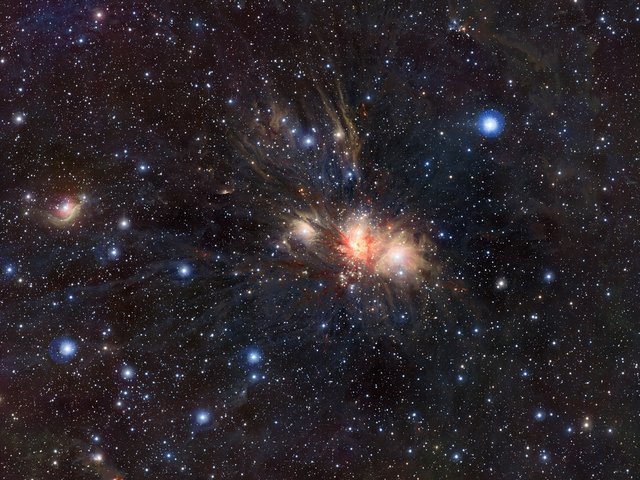Picture of The Day: Birth of a Star

Full size image
Whimsical swirls of gas, dark clouds and young stars in the Monoceros constellation. The VISTA telescope was able to see this magical creation of the Universe hidden behind clouds of interstellar dust and gas, at a distance of 2700 light years from Earth.
In the center of the picture is a newborn star under the name of Monoceros R2. Her young dense core has a volume of 2 light years. This is a small figure for the emerging stars, however, the radius of action of the gravitational force of our Sun is 1.5-2 light years too. In the case of new stars it's just a core!
Monoceros R2 is only beginning to emerge, the process of birth will take several million years. Gradually, its core will begin to contract, collecting all the hydrogen in a radius of several light years and absorbing nebula NGC 2170, behind which Monoceros R2 is hiding in this picture. At some point, under the action of gravitational forces will start the thermonuclear reaction of hydrogen and Monoceros R2 will become a full-fledged star, a huge ball of plasma.
In most cases, it is impossible to see the birth of stars even in the infrared range, because too dense clouds of cosmic dust in the region of star formation absorb any emitted and reflected light. But we are very lucky with the Monoceros R2, we can observe not only the epicenter of the birth of a star, but even the flow of the stellar wind around it.
You can also see this region in visible spectrum using the service: aladin.u-strasbg

In the visible spectrum huge accumulation of cosmic dust looks like an impenetrable black clouds.
#Sciencepop - science popularization. I suggest you use this tag in order to share interesting news, photos, stories from the world of science in a short format. Hundreds of scientific discoveries occur around the world every day. But they may contain insufficient data to create a full-fledged article or seem rather boring for usual readers, because of the strong scientific specifics. Although, I see that steemit community loves science in all its manifestations.

I've now seen a number of your posts (upvoted where I could), so I think it is time for me to click on the follow button.
Talking about births and deaths of suns, I've been more fascinated (and distressed) by the collision of galaxies. As with all life, the collision of galaxies must cause untold deaths of solar systems, perhaps many with intelligent life, but, I tell myself, perhaps this is just another way of creating new solar systems and life forms.
And if that is not enough - our own galaxy is heading for such a collision and exchange of stars. If most galaxies have a dark hole at the center, I wonder how often the black holes affect each other and become one - maybe as they attract energy and matter, they push each other apart? I don't know, but it is fun making up the questions for my stories.
This is VERY well written! The death and birth of stars is one of my favorite things about the universe!
Yes, this is a process that captures the imagination. It would seem it always runs the same, but at the same time, each star looks unique.
Sneaky Ninja Attack! You have been defended with a 0.35% vote... I was summoned by @thatsweeneyguy! I have done their bidding and now I will vanish...Whoosh
The advancement of technology is progressing very fast. At some point in the future we will see the stars form. Greetings @natord.